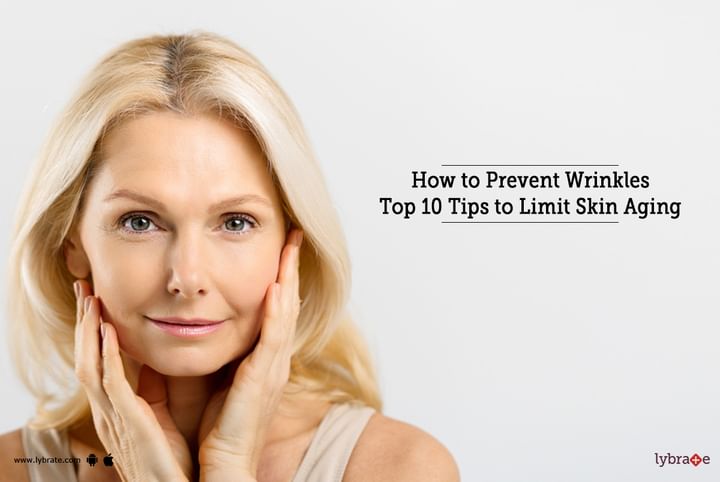Get the App
For Doctors
Login/Sign-up
Last Updated: Mar 14, 2023
BookMark
Report
How to Prevent Wrinkles: Top 10 Tips to Limit Skin Aging
Dr. BrijeshCosmetic/Plastic Surgeon • 16 Years Exp.MBBS, DNB General Surgery, M.Ch - Burn, Plastic and Reconstructive Surgery
What are Wrinkles?
Wrinkles are lines or creases in the skin that can be caused by a number of different factors. As we age, our skin loses its elasticity and wrinkles begin to form due to the breakdown of collagen and elastin, two proteins responsible for providing the skin with structure and volume.
Sun exposure is also a major contributor to wrinkles, as UV rays break down the proteins in the skin, resulting in sagging and wrinkling. Other causes of wrinkles include smoking, stress, sleep deprivation, genetics, and some medical conditions.
Types of Wrinkles
- Dynamic wrinkles: Dynamic wrinkles are caused by the natural movements of facial muscles when we smile, laugh, frown or squint. They are typically seen on the forehead and around the eyes. Examples of dynamic wrinkles include crow’s feet and forehead lines.
- Static Wrinkles: Static wrinkles are permanent creases and furrows in the skin that become more pronounced over time due to sun exposure, smoking, and the natural aging process. These wrinkles tend to be deeper than dynamic wrinkles and they can be seen on areas of skin that don’t move much such as the cheeks, nose, and lips. Examples of static wrinkles include marionette lines, smile lines and nasolabial folds.
- Frown Lines: Frown lines are vertical creases between the eyebrows that form when you make facial expressions like frowning, squinting or raising your eyebrows in surprise or anger. They are also known as “11” lines because they resemble two parallel number 11s on either side of your brows.
- Crow's Feet: Crow’s feet are small wrinkles near the outer corners of your eyes that usually appear around age 40—though some people may get them earlier due to sun exposure or smoking habits. They form when you squint or laugh often and can be reduced with Botox injections or laser treatments.
What are the signs and symptoms of Wrinkles?
The following are some of the signs and symptoms associated with wrinkles:
- Visible Lines: Wrinkles are most commonly characterized by visible lines on the skin. These lines can be either shallow or deep, and they can appear in different parts of the body, such as around the eyes or mouth.
- Sagging Skin: People's skin loses elasticity and firmness as they age. Sagging skin appears in places such as the cheeks, forehead, and neck as a result.
- Dry Skin: Dryness is another common symptom of wrinkles. It may be accompanied by flaking or itching.
- Age Spots: Age spots are dark spots that appear on areas exposed to the sun over time. They can also be an indicator of wrinkles as they become more prominent over time due to sun exposure.
What are possible complications of Wrinkles?
- Reduced self-esteem: Wrinkles can cause people to feel self-conscious and unattractive, leading to a decrease in self-esteem.
- Difficulty with facial expressions: Deep wrinkles may impede the natural range of motion of facial muscles, making it difficult for people to express their emotions through facial expressions.
- Increased sensitivity to ultraviolet radiation: Wrinkles can make the skin more susceptible to sun damage and skin cancer due to increased exposure of delicate skin tissue.
- Changes in vision: Some wrinkles may cause sagging of the eyelids, leading to reduced peripheral vision and difficulty with focusing at close range.
How to Prevent Wrinkles: Top 10 Tips to Limit Skin Aging
- Sunscreen: Applying sunscreen on a daily basis is one of the most important steps you can take to prevent and reduce wrinkles. UV rays can cause damage to the skin and lead to premature aging, so using a broad-spectrum sunscreen with at least an SPF of 30 can help protect your skin from further damage.
- Retinoid Creams: Retinoid creams, such as tretinoin or retinol, are topical treatments that can help reduce the appearance of wrinkles. They work by increasing cell turnover, which can help smooth out fine lines and wrinkles.
- Use Antioxidants: Antioxidants such as Vitamin C and green tea extract can help protect your skin from free radical damage caused by UV rays, pollution and other environmental factors that can contribute to premature aging.
- Eat Healthy Foods: Eating a balanced diet with plenty of fruits and vegetables rich in antioxidants is important for overall health and skin health too. Fruits and vegetables contain vitamins A, C, E, B6 and B12 which are all beneficial for healthy skin cells.
- Stay Hydrated: Drinking plenty of water throughout the day helps keep your body hydrated from the inside out, which is important for keeping your skin looking healthy and youthful.
- Quit Smoking: Smoking has been linked to premature aging due to its damaging effects on the body's collagen levels, leading to deeper wrinkles around the eyes and mouth area in particular.
- Exercise Regularly: Exercise helps increase circulation throughout the body which helps keep skin looking fresh and youthful while also helping prevent wrinkles caused by muscle tension in the face such as frown lines or forehead furrows.
- Moisturize Regularly: Moisturizing is an essential step in any skincare routine as it helps keep your skin hydrated while also helping to protect it from environmental stressors that can contribute to premature aging over time such as UV rays or dry air conditions.
- Get Enough Sleep: Getting enough sleep is essential for overall health but it also plays an important role in keeping your skin looking healthy too! Not getting enough sleep has been linked with more pronounced wrinkles due to decreased collagen production during sleep deprivation periods so make sure you’re getting at least 7-8 hours each night!
Try these home remedies
- Apply Aloe Vera Gel: Aloe vera gel is known for its anti-aging properties, and it is a great remedy for wrinkles and fine lines. The gel contains antioxidants that help protect your skin from sun damage and other environmental stressors.
- Try Coconut Oil Massage: Coconut oil is a great natural moisturizer, which can help prevent wrinkles from forming by keeping the skin hydrated. Massaging your face with coconut oil can also reduce the appearance of existing wrinkles by stimulating collagen production.
- Apply Turmeric Face Pack: Turmeric has antiseptic, anti-inflammatory, and antioxidant properties that can help reduce wrinkles and make your skin look younger. Make a paste by combining turmeric powder with honey or milk, then apply it on your face for 20 minutes before washing it off with lukewarm water to get rid of wrinkles naturally.
- Try Fenugreek Seeds: Fenugreek seeds are high in protein and amino acids that can boost collagen production, making them a great remedy to get rid of wrinkles naturally at home. Soak a tablespoon of fenugreek seeds overnight in water, then grind them into a paste and apply it on your face every day for best results.
In the event that none of these therapies are successful, your only option may be surgical procedures.
What are the surgical treatments for Wrinkles?
- Facelift: A facelift is a surgical operation that removes extra skin and fat from the face and neck to improve facial features and minimise wrinkles.
- Brow Lift: A brow lift is a surgical technique that raises the brows and reduces the appearance of deep creases on the forehead.
- Eye Rejuvenation: Eye rejuvenation is a process that is intended to remove wrinkles, puffiness, and dark circles around the eyes. It can also be used to make the upper eyelids appear more youthful.
- Neck Lift: Neck lift surgery removes extra fat and skin from the neck area, eliminating wrinkles and improving facial lines.
- Skin Resurfacing Procedures: Laser resurfacing, chemical peels, and dermabrasion can all be used to eliminate fine lines and wrinkles on the face, as well as improve skin tone and texture.
Best doctors to consult for Wrinkles
- Dermatologist: A dermatologist is a doctor who specialises in skin, hair, and nail conditions. They are capable of diagnosing and treating wrinkles, UV damage, age spots, and other skin problems.
- Plastic Surgeon: A plastic surgeon can help reduce the appearance of wrinkles with procedures such as Botox and chemical peels. They may also recommend more invasive procedures such as lasers or facelifts for more dramatic results.
- Primary Care Physician: Your primary care physician can provide advice on lifestyle changes that can help prevent wrinkles from appearing or worsening, such as quitting smoking and limiting sun exposure. They may also recommend over-the-counter treatments that can help reduce wrinkles, such as topical retinoids or alpha hydroxy acids.
In case you have a concern or query you can always consult a specialist & get answers to your questions!



+1.svg)
